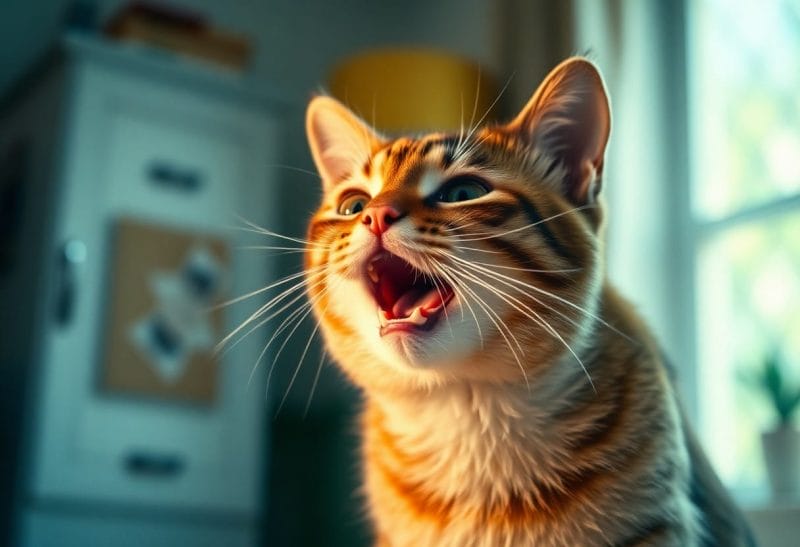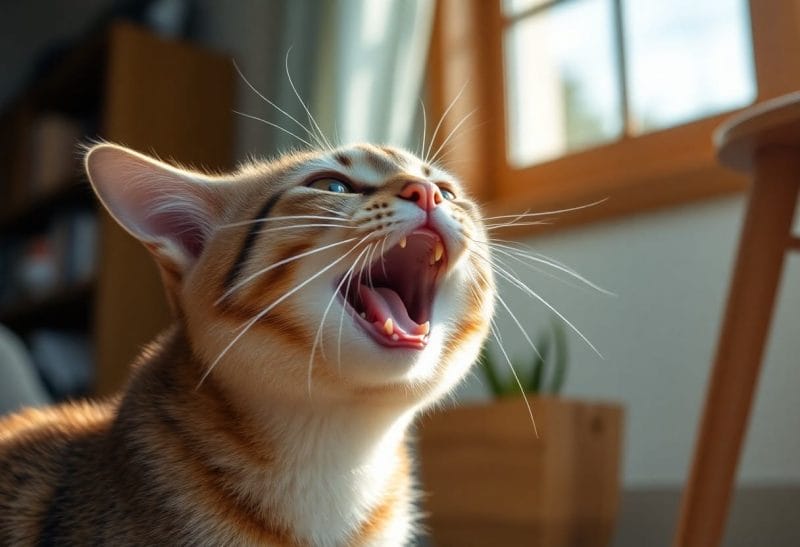What are cats natural sound? Just like humans have their unique way of expressing emotions, cats communicate through a variety of natural sounds. Understanding these sounds can enhance your bond with your feline friend, as each meow, purr, or hiss conveys specific feelings or needs. In this post, you will discover the different types of sounds your cat makes, what they signify, and how to interpret them for a better understanding of your pet’s emotional state. Armed with this knowledge, you can foster a more harmonious relationship with your furry companion.

Key Takeaways:
- Vocalizations: Cats produce a variety of sounds, including meows, purrs, and hisses, each serving different communication purposes.
- Body Language: Alongside vocal sounds, a cat’s body language plays a significant role in their natural communication with humans and other animals.
- Social Interaction: Domestic cats often alter their natural sounds to communicate effectively with humans, showcasing their adaptability and social nature.
Understanding Cat Sounds
The world of cat sounds is diverse and complex, giving you insight into your feline friend’s emotions and needs. Each sound carries its own meaning and can indicate everything from contentment to distress. By learning to interpret these sounds, you can better understand your cat’s feelings and enhance your relationship with them.
The Types of Sounds Cats Make
Along with their diverse array of vocalizations, cats communicate using body language. Here’s a breakdown of the most common sounds you might encounter:
| Sound Type | Meaning |
|---|---|
| Meow | Commonly used to communicate with humans. |
| Purr | Indicates contentment or comfort. |
| Hiss | Sign of fear or aggression. |
| Chirrup | Used to get attention or express excitement. |
| Yowl | Can indicate distress or alert you to a problem. |
- Each sound serves different purposes, ranging from seeking interaction to expressing discomfort.
- As you observe your cat, take note of their vocalizations in various situations.
- Familiarize yourself with the context in which these sounds occur.
- Significant changes in their vocal habits can be a signal for a visit to the vet.
- Assume that your cat is communicating more than just basic needs if you actively listen.
The Purpose Behind Each Sound
Sounds made by cats have distinctive purposes, all serving to convey information to you and other animals. Cats are uniquely adept at communicating their needs and feelings in specific ways, such as meowing more frequently if they want food or using a low growl to express discomfort. Each sound becomes a tool for interaction, making their emotions more transparent.
It is important to note that your cat may use a sound in a specific context, which can change its meaning. For instance, a meow that usually signals “I’m hungry” may take on a different meaning when coupled with a particular body posture or time of day. By paying attention to how your cat uses their sounds in various situations, you gain a richer understanding of their emotional landscape, further strengthening your bond with your furry companion.

The Science of Cat Vocalizations
One of the fascinating aspects of feline behavior is their vocalizations. Understanding the science behind how cats produce sounds can give you valuable insight into your pet’s communication. Cats possess a unique laryngeal structure, which enables them to create a wide variety of vocal sounds, including meows, purrs, and hisses. This intricate design allows for versatility in pitch and tone, making it possible for your cat to express their emotions and needs effectively.
The Anatomy of Cat Vocal Cords
Among the key components in producing sounds are the cat’s vocal cords, which are located within the larynx. Unlike humans, cats have an additional pair of vocal cords that allow them to produce a higher range of frequencies. This is part of the reason why cat vocalizations can be so varied and expressive. Additionally, their flexible laryngeal muscles enable them to manipulate the airflow and vibrations through the vocal cords, leading to distinctive sounds tailored to specific situations.
How Cats Learn to Communicate
With time and experience, cats hone their vocal skills to align with your expectations and respond to your cues. They may start off using instinctual sounds as kittens, but as they grow, they learn to adapt these sounds based on your reactions and those of their environment. The bond you share plays a significant role in how your cat modifies its vocalizations to effectively communicate its feelings and desires.
A cat’s ability to learn and modify its vocalizations relies heavily on their social interactions. They observe and respond to your behaviors, which influences how they express themselves. For instance, if you respond positively to a certain meow for food, your cat may continue to use that specific sound to gain your attention in the future. This form of learning highlights the deep connection between you and your feline companion, leading to a more profound understanding of each other’s communication styles.

The Role of Body Language in Cat Communication
Your understanding of cat communication extends far beyond just the sounds they make. In fact, body language plays a significant role in how your feline expresses emotions, desires, and even discomfort. For example, a relaxed cat may have a loose body posture and a gently flicking tail, while a puffed-up tail indicates fear or aggression. By observing these subtle cues, you can gauge how your cat is feeling and respond accordingly, which is vital for building a strong bond with your pet.
You can enhance your insights into your cat’s behavior by combining your observations of their sounds with their body language. When your cat meows, for instance, the context of their posture and tail position can provide additional clues about their intentions. For more information on the various sounds your cat makes, you might find it useful to check out What Do Different Cat Noises and Sounds Mean?. Understanding this holistic approach to feline communication not only enriches your experience as a pet owner but also helps you create a more harmonious living environment for both you and your cat.
Differences in Vocalization Across Breeds
Keep in mind that vocalization can significantly differ across cat breeds, each possessing unique traits that influence the sounds they make. For instance, the Siamese cat is known for its loud, distinctive meowing, often described as a “talkative” breed that seeks to engage you in conversation. On the other hand, breeds like the British Shorthair tend to be more reserved, with a softer purr or gentle chirp that reflects their calm demeanor. Understanding these breed-specific vocalization patterns can enhance your connection with your feline companion, providing insights into their personality and needs.
Additionally, it’s fascinating to explore how various breeds communicate through noises beyond the common meow. You may come across different terms that cat owners use to identify these sounds; for example, some might refer to the contented trills or the soft chattering that occurs when your cat is watching birds outside. To dive deeper into the many different noises a cat makes to communicate, visit What do you call the many different noises a cat makes to…. This awareness can enrich your understanding of your pet’s behavior and assist you in responding more effectively to their vocal expressions.
Common Misunderstandings About Cat Sounds
Once again, it’s important to address some common misconceptions surrounding the sounds your cat makes. Many people believe that a cat’s meow is exclusively a sign of affection or a desire for attention. While it’s true that cats often meow to communicate with their owners, they also use this vocalization for other reasons, including hunger, discomfort, or a need for social interaction. Understanding the context in which your cat is meowing can help you better interpret their needs and feelings.
Another misunderstanding revolves around purring. Many assume that when a cat is purring, they are always content or happy. However, cats also purr when they are in pain or feeling anxious as a self-soothing mechanism. It’s vital to pay attention to your cat’s body language and overall behavior to get an accurate picture of their emotional state. By being aware of these common misconceptions, you can foster a deeper bond with your feline friend and be more attuned to their unique ways of communicating.
How to Interpret Your Cat’s Noises
Unlike many pets, your cat’s vocalizations can be quite varied and nuanced, each sound often conveying different emotions or intentions. When your cat meows, it may be a request for attention, food, or even an expression of discomfort. Pay attention to the pitch and frequency of these meows; a high-pitched meow could indicate excitement or anxiety, while a lower growl might suggest irritation or fear. By observing the context in which these sounds occur, you can begin to decipher what your cat is trying to communicate.
Additionally, your cat may make other sounds you need to consider. Purring is typically associated with contentment, but it can also signal pain or distress in some situations. Hissing and growling are signs of aggression or fear, indicating that your cat feels threatened. Chirps and trills, on the other hand, might be your cat’s way of expressing delight or soliciting your attention in a playful manner. By keenly observing your cat’s body language alongside its vocalization, you’ll gain a clearer understanding of its emotional state and needs.
Summing up
Now that you have explored the natural sounds of cats, you can better understand their communication methods. The most common vocalizations include meowing, purring, hissing, and growling. Each sound serves a distinct purpose, whether it’s to solicit attention, express contentment, or warn of potential danger. By paying attention to these sounds in conjunction with your cat’s body language, you can gain deeper insights into your pet’s feelings and needs.
Additionally, it’s worth noting that the sound a cat makes can vary based on its breed, personality, and experiences. You may find that your own cat has its unique way of expressing itself, which adds to its charm. By fostering a closer relationship with your feline friend, you can enrich your interactions and enhance your understanding of its natural behavior. Engaging with your cat and responding to its sounds will only strengthen your bond.
FAQ
Q: What sounds do cats naturally make?
A: Cats produce a variety of natural sounds including meowing, purring, hissing, chirping, and growling. Each sound can convey different emotions or messages. For example, meowing is often a way for cats to communicate with humans, while purring usually indicates contentment.
Q: Why do cats meow?
A: Cats predominantly use meowing as a means of communication, especially with humans. Kittens meow to their mothers for attention, and as they grow, they continue to meow to express needs such as hunger, discomfort, or affection. Adult cats may also meow to solicit attention or playtime.
Q: What does it mean when a cat purrs?
A: Purring is typically associated with a state of relaxation and pleasure in cats. However, cats may also purr when they are frightened or in pain as a self-soothing mechanism. It’s important to observe their body language and the context to interpret the purring accurately.
Q: Why might a cat hiss?
A: Hissing is a defensive sound that cats make when they feel threatened or scared. It acts as a warning to potential threats to keep their distance. A hissing cat may feel cornered or may be displaying aggression, so it’s advisable to give them space during such times.
Q: What does chirping indicate in cats?
A: Chirping, or chattering, often occurs when cats are watching birds or small prey animals. This sound could reflect excitement or frustration at being unable to reach the object of their interest. Some experts suggest it might mimic the call of their prey, increasing their chances of a successful hunt, even if the cat is indoors.










